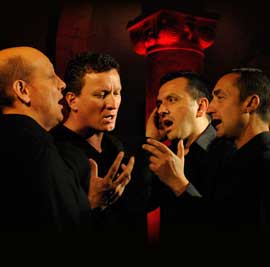The Voice of Ecstasy: Shape-note Singing and Polyphony
“Ecstasy means the state that comes from listening to music.” —Al-Ghazali
The Glass Harmonica is a novel about love and loss. It’s about daring to be free and about the costs of freedom. Music is a powerful force in the book, leading the main character, Chjara Vallé, to love more than she should. And to be more free than is wise for a woman. Benjamin Franklin’s instrument is only part of the story. On this page, you can discover some of the other music that inspires Chjara to risk ecstasy.
 Corsican polyphony is one of the ancient forms of chanting, like Gregorian chants but sung often in taverns instead of cathedrals. A chant might be about a shepherd’s loneliness, all alone on a mountain at night without family or friend nearby. Or it can be about the barbarous fortune, barbara furtuna, of emigrating and never being able to go home again. Listen to the song Barbara Furtuna. Chjara, as a very young girl, sings this song in the opening chapter of The Glass Harmonica, and she learns from music that men want to be led to their feelings. Read the excerpt.
Corsican polyphony is one of the ancient forms of chanting, like Gregorian chants but sung often in taverns instead of cathedrals. A chant might be about a shepherd’s loneliness, all alone on a mountain at night without family or friend nearby. Or it can be about the barbarous fortune, barbara furtuna, of emigrating and never being able to go home again. Listen to the song Barbara Furtuna. Chjara, as a very young girl, sings this song in the opening chapter of The Glass Harmonica, and she learns from music that men want to be led to their feelings. Read the excerpt.
Chjara feels God in her body. Her moist fingers on the bowls of the glass harmonica connect her to God’s vibrating world. Sex gives her, as the Puritans said, a foretaste of the union with God in heaven. Where she sees her body leading her to virtue, others see vice. At a moment when she is abandoned and scared, she sings and growls simultaneously. In this way, she discovers throat singing or the similar overtone singing. The human voice can create two notes at once, splitting into a bass note and an overtone. Try it:
Chjara makes a friend in New England who takes her to a tavern where men and women together sing ‘shape notes.’ It was a style of notation and of music – no vibrato, with the singers facing each other in a square and basically shouting the notes at each other until the whole room practically shook. This music was popular in early America and is making a comeback. Check out a local sing near you at http://fasola.org/. Anyone can join.





